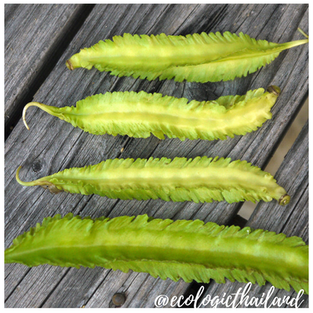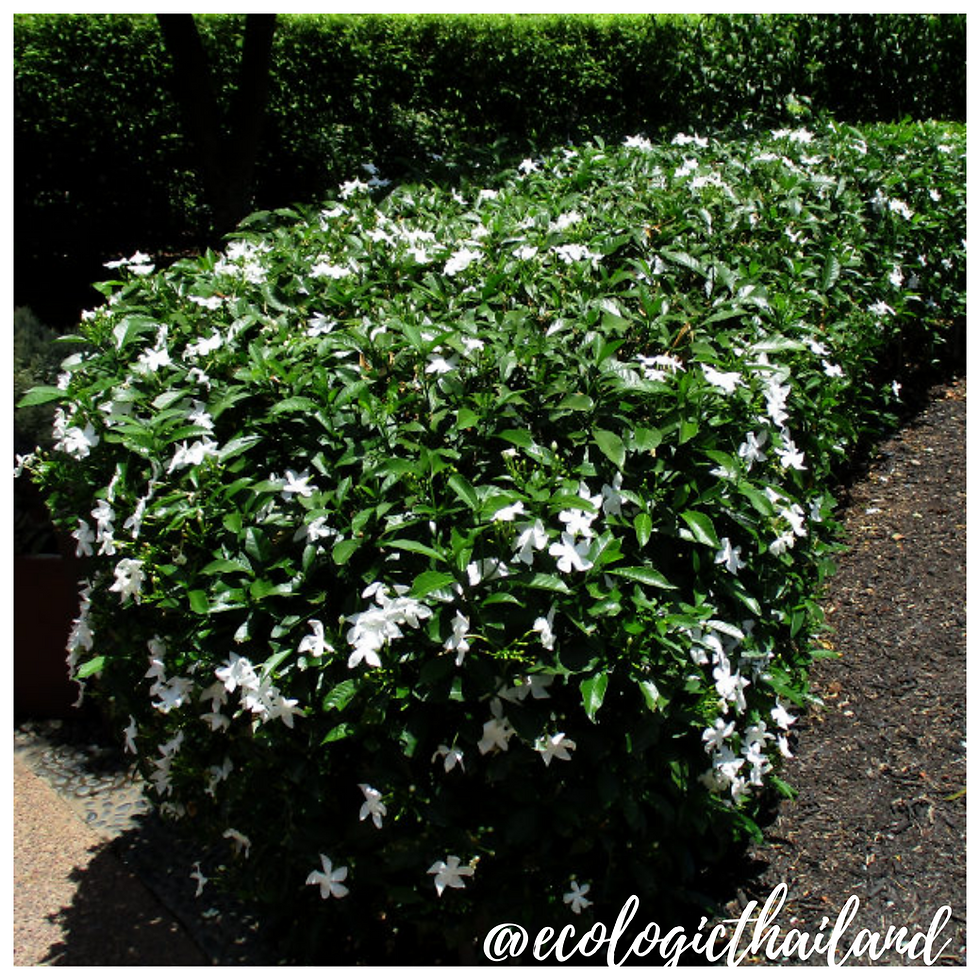Winged bean
- Eco-Logic Resort
- Dec 22, 2020
- 3 min read
Updated: May 31, 2021
Thua Phu | ถั่วพู | Psophocarpus tetragonolobus
Family: Fabaceae | Genus: Psophocarpus

Winged beans grow in the aqua hydropic area on the premises of the Thai Child Development Foundation.
The winged bean, also known as the goa bean, four-angled bean, four-cornered bean, manila bean, princess bean, cigarrillas, asparagus bean, dragon bean, is a tropical vegetable.
Winged beans have tuberous roots and pods with wings (hence the name). The winged bean plant grows as a vine, they can climb by twining their stems around a support, growing up to 2–4 meter long.
The winged beans are ready for harvest within three months of planting.

THE SHRUB/VINE
Winged beans have tuberous roots and pods with wings (hence the name). The winged bean plant grows as a vine, they can climb by twining their stems around a support, growing up to 2–4 meter long
All parts of the plant are edible.

THE LEAVES
The shape of its leaves ranges from ovate to deltoid, ovate-lanceolate, lanceolate, and long lanceolate. The green tone of the leaves also varies. The stem, most commonly, is green, but sometimes boasts purple.
Leaves are edible. The young leaves can be picked and prepared as a leaf vegetable, similar to spinach.

THE FLOWERS
The large flower is a pale blue.
Flowers are bisexual, papilionaceous and of varying colors pale sky blue, white, reddish brown depending on cultivars.
The flowers are used to color rice and pastry.
Flowers are edible.

THE BEAN POD AND BEANS
The bean pod is typically 15–22 centimeter long and has four wings with frilly edges running lengthwise.
The skin is waxy and the flesh partially translucent in the young pods.
The pods are usually rectangular in cross-section, but sometimes appear flat. Pods may be colored cream, green, pink, or purple.
Pods may be smooth are appear smooth or rough, depending on the type.
Seed shape is often round; oval and rectangular seeds also occur. Seeds may appear white, cream, dark tan, or brown, depending on growing and storage conditions.
When the pod is fully ripe, it turns an ash-brown color and splits open to release the seeds.
The beans themselves are similar to soybeans in both use and nutritional content.

THE TUBER
The fibrous roots are numerous with the main roots running horizontally near the soil surface; after a few months they usually become thickened and tuberous, near the base of the plant, though this does not occur in all strains.
Root Tubers of the winged bean can be eaten raw or cooked.
The nutrient-rich, tuberous roots have a nutty flavor.
CULINARY USES
Winged bean is nutrient-rich, and all parts of the plant are edible.
Leaves can be eaten like spinach, flowers can be used in salads, tubers can be eaten raw or cooked, seeds can be used in similar ways as the soybean.
The leaves, flowers, roots, and bean pods can be eaten raw or cooked; the pods are edible even when raw and unripe. The seeds are edible after cooking.
Beans can be made into milk when blended with water and an emulsifier. Winged bean milk is similar to soy milk, but without the bean-rich flavour.
The seeds require cooking for two to three hours to destroy the trypsin inhibitors and hemagglutinins that inhibit digestion. They can be eaten dried or roasted. Dried and ground seeds make a useful flour, and can be brewed to make a coffee-like drink.
The flavor of raw beans is not unlike that of asparagus.
At Eco-Logic's restaurant 'The Food Forest Kitchen' the winged bean can be served as a stir fry or in one of the delicious Thai salads. Click on the logo to find a recipe.
NUTRITION
The entire winged bean plant is edible. Each of these parts contains vitamin A, vitamin C, calcium, and iron. And the beans are rich not only in protein, but in tocopherols (antioxidants that facilitate vitamin A utilisation in the body).
TRADITIONAL MEDICINAL USE
NOTE: please take advice from a doctor if you are planning to use herbal medicine.
Winged bean has been commonly used in traditional medicine for many years. Winged bean possess bioactive phytochemicals with antioxidant properties, so it’s considered a putative promising resource for treating diseases related to oxidative stress and inflammatory reactions.
INTO THE WILD: a down to earth experience

For guests and visitors to Paksong we organize weekly tours "The Edible Forest" and Foraging weekends: Into the Wild. We work with local guides to take you in the jungle of Paksong. After foraging, we will cook a meal with the ingredients, using bamboo together with you!
Come and join and learn about the abundance of food that nature gives us!
INTO THE WILD!


















Comments